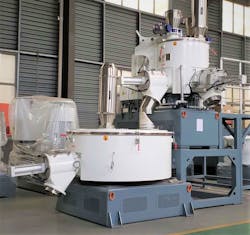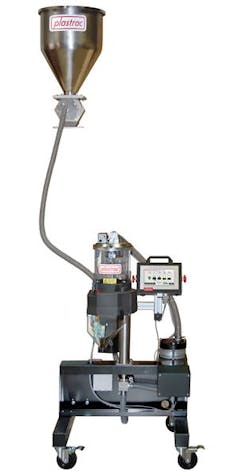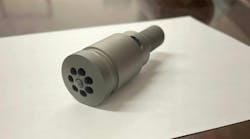Among the mixing and feeding technologies creating a stir at K 2019 were several that drew inspiration from the challenges posed by blending and purging color. While Beier introduced a host of next-generation machines, Plastrac shook things up with an arrangement that turns the typical feeding setup on its head. Meanwhile, Advanced Blending Solutions has launched a new clean-out system.
Beier Machinery
The first of the new-generation mixers to hit the U.S./Canadian market arrived at the company’s Ohio warehouse and showroom in October, with the first U.S. customer scheduled to receive a mixer in December.
The mixers include 11 models in the SHR line with capacities ranging from 5 liters to 800 liters and outputs ranging from 17.6 pounds per hour to 2,910 pounds per hour.
The SHR mixers are mainly used for mixing color concentrates, PVC compounds and rotational molding materials. They are effective at mixing color and other additives into resins. The mixers incorporate advanced designs; can be operated easily, safely and reliably; have a small footprint; and run quietly and efficiently, the company said.
Beier’s SRL-Z series of mixer/cooler combinations is designed to produce PVC compounds, according to the company. The hot mixer thoroughly mixes and heats the PVC ingredients. The compound then is automatically discharged into a cooling mixer, where it is cooled to a point that all the plasticizers are absorbed into the finished PVC compound.
The four models within the SRL-Z series have outputs ranging from about 363 pounds per hour to 1,818 pounds per hour.
Beier’s SRL-W horizontal mixer/cooler units are ideal for mixing and cooling PVC and heat-sensitive materials, the company said.
The SRL-W series uses advanced technologies that give it the ability to mix under a vacuum. The mixing and cooling cycles are controlled by a PLC, and the mixing and cooling blades are made from cast stainless steel. The four models in the series have maximum outputs of about 1,818 pounds per hour, 2,910 pounds per hour, 3,637 pounds per hour and 5,820 pounds per hour.
All of the upgraded models now include automatic air-blow clean-out systems and large doors on the discharge sections to provide access for cleaning.
In addition, the mixer/coolers now have reduction gearboxes and can operate independently of the hot mixer. The hot mixer and cooling mixer have independent air and water piping and separate electrical circuits.
Blending equipment maker Plastrac has upended the typical configuration for feeding systems with ColorStream, its new cart-mounted color-feeding system.
In typical setups, the color and additive feeders are located above the processing machine — often at a mezzanine level — and use gravity to feed materials into the processing machine. Such systems employ vacuum loaders to carry the main ingredient into the extruder or injection molding machine, where it is metered into the process. Because they are located above the processing machine, these conventional feeders can be difficult or dangerous to access for cleaning or maintenance.
Inspired by a cable and wire manufacturer that wanted to avoid the need for employees to climb ladders or stairs to swap additive hoppers, Plastrac designed its system so users could perform cleaning and color changes on ground level. With its ColorStream system, as many as four additive feeders can be arranged in a circle on a cart, with a hopper containing the main resin located above a cart. The additives are metered into a Venturi pump and carried by air from a regenerative blower through a tube to a baffle box located below the hopper, where they are blended with the main ingredient and fed into a press or extruder. Color and additives merge with the main ingredient just above the feed throat of the machine, eliminating the need for stirring mixers and the potential buildup of static that could result in poor blending quality, President Ken Bullivant said.
A typical baffle box can handle more than 2,000 pounds per hour.
The ColorStream is similar to conventional feeding systems in that it has no feeder for the main ingredient.
“Since the total blend rates can be many hundreds of pounds per hour and the main ingredient can be as much as 99 percent of the total blend, elimination of a main ingredient feeder saves significant space and investment,” Bullivant said.
The ColorStream system is particularly appropriate for processors that only occasionally process color additives, he said. Baffle boxes can be mounted on every processing machine, so that they can be connected a ColorStream cart when a process requires color mixing.
According to Plastrac, the patent-pending system is safer than traditional designs. It is user-friendly and reduces costs. Importantly, the components of the system are designed to eliminate the need for above-the-ground cleaning and maintenance. For example, to eliminate maintenance requirements, the baffle box has been outfitted with a metal screen to prevent resin pellets from escaping, and transport air ensures pellets do not clog up the system. Also, because they have no contacting parts requiring lubrication, the ColorStream’s blowers could operate continuously for years without maintenance, the company said.
With the system, which can handle the same feed rates and throughput as traditional designs, companies could be relieved of the need for mezzanines.
“Not only did it solve a customer problem,” Bullivant said in a press release, “it is going to save them a lot of money for years to come.”
Advanced Blending Solutions
Advanced Blending Solutions has developed a new version of its automated clean-out system for its line of gravimetric blenders.
The system, called the Chameleon 2.0, uses automated chutes to remove material from a blender’s feeder tray; it feeds the material into a removable container for later use or into a stationary surge hopper so that it can be conveyed to a collection station. The chute system allows all of a blender’s various components to discharge their contents simultaneously, drastically decreasing the time to complete a material changeover. The system’s predecessor, the Chameleon Simplicity 3000, used a rotating head instead of an automated chute system.
The system uses vacuum and compressed air to clean the blender’s vacuum receiver and material hoppers.
With the Chameleon 2.0, the time required for material changeover is significantly reduced, meaning that less material is wasted. The technology increases equipment run time. The Chameleon 2.0 is only available on new blenders and cannot be retrofitted to old equipment.
In addition, material now is collected directly below the blender in the removable container or stationary surge hopper, rather than in a secondary location. The hopper includes an automatic slide gate that controls material flow into a conveyor line. Both the removable container and hopper have level sensors to pause the cleanout if they are full. Both types of containers can be used together on a single blender frame, giving customers flexibility in how they handle the clean-out process, the company said.
Contact
Advanced Blending Solutions LLC, Wallace, Mich., 906-914-4180, www.adv-blend.com
Beier America, Exeter, N.H., 603-502-9405, www.beieramerica.com
Plastrac Inc., Edgemont, Pa., 610-356-3000, www.plastrac.com








